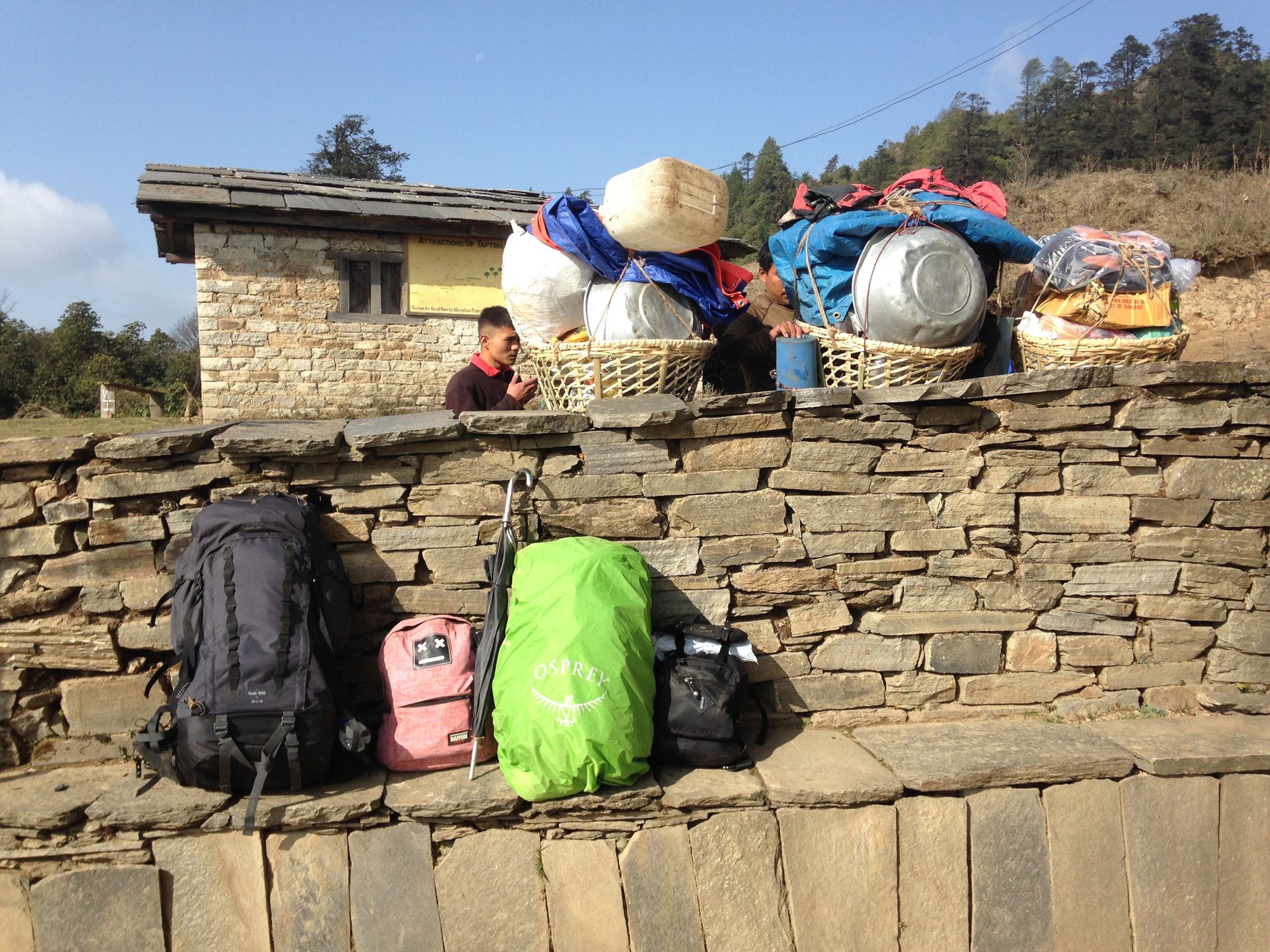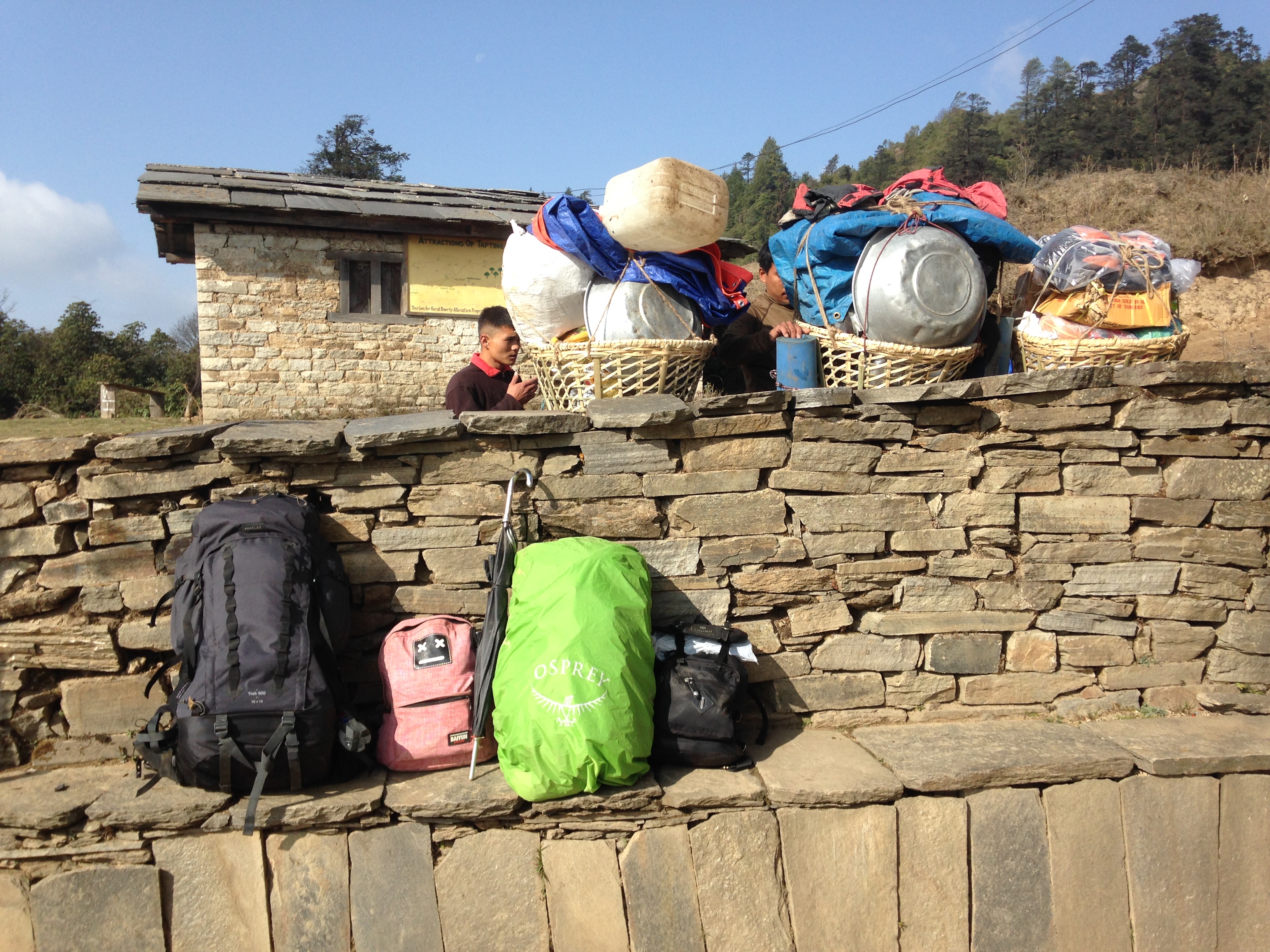Essentials to bring to remote areas in Nepal

What should you bring?
Having travelled for research to about 23 remote VDC’s in Nepal, in Gorkha and Okhaldhunga, mainly with local transport and by foot, we have been able to find out what is the bare minimum you should take to the field. When you hike for 5 to 8 hours, you really want to know what is essential and what is not. Every kilogram counts when you are hiking up for hours or walking on a dangerous narrow trail with wind.
Some of our team members seriously over packed! Hopefully we can help you to take less. Note that, our Nepali translators travel with only a fraction of what is on this list. They only take; one pair of extra trousers, one extra shirt, a rather warm jacket, slippers, a toothbrush, a block of soap, some underwear and a power bank. Therefore, this advice is definitely not useful for Nepali. Have a look at this list and decide for yourself if you can still take less.
This list is made based on our field work between February and May 2018 in remote areas. If you are hiking as a tourist this list is not for you! In remote areas, people are more helpful in remote areas, prices are different and sleeeping and transport conditions are more limited.
Essentials
Decent sleeping bag
In most homestays the hosts can provide some blankets for your team. They will have spare blankets for 2-4 persons. Therefore, most of our Nepali translators did not have sleeping bags. If you are traveling in a group of 4-6 you should provide sleeping bags for most of the team members. Besides that, the blankets are not always warm enough.
You might really regret not having invested in a good sleeping bag. In Europe, you will find sleeping bags that give comfort below 5 degrees for around 150 to 200 euro. In the Kathmandu, in the touristy neighbourhood Thamel, you will surely find something cheaper and of high quality. In Kathmandu, there is a big demand of sleeping bags for all the hikers so you will easily be able to find one. I had decided to take a cheaper light weight sleeping bag that said it would give comfort to 5 degrees which was definitely not the case. While others were sleeping like babies, I stayed awake because of the cold. Warm layers can help you through the night but imagine you sleep in a barn or a house without shutters doors or windows. Sometimes you practically sleep outside. We travelled in March and April and both in the lower and higher areas of Gorkha it has been cold during the night.
Warm clothes
If you are going above 2000-3000m then you would need to ensure you have really warm clothes. If it is lower, between 1000 and 2000m you might not need too many layers but you need warm clothes. In February and March it is still snowing in some areas. It can be so cold! Are you going to the valley or are you hiking up from the valley? That makes a big difference in temperature. Nevertheless, in the higher communities above 1000m, in the morning and evening it is cold! You might not expect that when you leave from 30 degrees in Kathmandu.
Especially if your sleeping back is not that warm, you really want to have some layers to sleep in. We would recommend some layers;
(1) a warm shirt, for example merino, (2) a fleece jacket, (3) a down jacket, (4) socks.
- We do endorse a merino shirt as you can wear it for several days without getting too smelly. You might consider long merino or thermal underclothing.
- A fleece jacket is super comfortable at night, during the day when you are sitting still, when you hike, and when you are inside a house at night. Do take one!
- Most Nepali wear down jackets, mostly a fake version of Nord face. You can buy all sorts in Kathmandu.
- Some of us had brought very warm socks. That is not really needed and sweaty when you walk. Are you going to areas where you might have snow? Then the situation might be different for you.
Water filter / water drops
In one community, our whole team became sick, acute diarrhoea during all our days in that community. We think it was the water from the mountain we tried on our hike up or, probably more likely, from the not so hygienic kitchen. Water is fine when it is boiled and mostly also when it comes from a tap in mountainous community. However, we do recommend you to bring a small bottle with some purification drops that help you to filter the water when you do not trust it.
Toilet paper
Bring toilet paper as you cannot buy it in most villages. You can also, like the locals, just use water instead.
Cash
You won’t find an ATM anywhere so make sure you have money for your whole trip! Some tips to help you estimate how much you need.
Food: You will probably have two dalh bat meals per day for around 150 – 250 NPr. Next to hiking trails such as the Manaslu trail you will pay at least double for your food. We paid between 500 to 900 per meal in tourist areas. Ask for the price list in those areas and consider buying some Samosas around the corner if you want to save money.
Accommodation: You can sleep for around 0 - 600 NPr per night per room. In some places, like in Manthali we were charged with 1000 NPr per room.
Transport: Local bus transport is sometimes available to bring you from one place to the next but in most cases you have to hike. The cost of bus transport depends on the condition of roads. Normally a bus ticket is around 100-200 NPr. In some cases you will be charged 1000 NPr per person because of the difficult road. If it is a bus to Kathmandu you will sometimes pay the full fare to Kathmandu although you won’t travel that far.
Permits and guides: If you work together with an (I)NGO you might be able to get a permit to enter in a protected area for free. Otherwise it will cost around 2000 NPr per day per person. Check out the permit prices for your area. In some areas, it is a legal requirement to have a guide and it will cost around 20 to 25 USD per day. However, you don’t need a guide to find your way in most areas. People will indicate you where to go next.
Power bank
Definitely useful! Bring a good one like 10mpA. In most places there will be electricity. However, you have power cuts and will not always be able to charge your equipment. Have it as a backup when you are doing surveys on mobile devices.
Non-essentials but useful to bring
Air matrass
In most homestays, you will sleep on a wooden layer, sometimes covered with a softer layer to sleep on. They will have space for 1-3 persons to sleep on such a layer. So, depending on the size of your team you don’t really need to bring an air matrass if you are a bit tough. We had brought air matrasses to sleep on for extra comfort but did not use it very often and did not really need it. We only had to use our air matrasses because our team was about 4-5 persons.
Shoes
Hiking shoes are heavy and you actually do not need it everywhere. If you are hiking close to known hiking trails or close to any village connected by road you don’t necessarily need it. Nepali just hike on their slippers or very simple hiking shoes without any relief. Besides that, if you bring normal sneakers you might feel more comfortable in meetings and in the community. Though, if you are hiking a lot or if you are traveling in the rainy season, which we do not recommend, the roads can be slippery and you might miss decent hiking shoes. Also outside the rainy season, the roads are narrow and it is easy to twist your ankle.
Slippers
If you are traveling in a group it might be nice to have 1 pair of slippers with you. It is useful when you go to the toilet/bathroom and inside houses. Though, you can do without it if needed. In most places, people might lend you slippers.
Small cash
We went high up in Gorkha district and we expected that people would not have change from 1000 NPr, what you normally get out of an ATM. Some people told us to make sure we had change. We managed to change our big bills for smaller bills in local shops in Gorkha town. We ended up having about a kilo of cash. Useless! If you stay a few nights in one place you will get one bill with the food and accommodation together. This will be around 500-1000 NPr per person per day in communities. Especially those with a small shop or hotel have change. Nevertheless, try to take some 100 and 500 bills with you.
Multifunctional rain cover / flight bag
One of our team members had a rain cover that you can also use as a flight bag. That is useful since your bag will end up in a pick up or on the roof of a bus and will get really dusty. Some of us used our rain cover in those cases but it will still get dusty from one side.
Rain protection
In Feb, March, April, May it does not rain that much that you actually need a rain cover for your backpack. It is not really essential to bring maybe. However, if you are hiking and it rains there is no escape. Some of our team members had a cheap rain cover made in the field by a local tailor. In Kathmandu, they sell cheap waterproof bags and those allow you to have your essential equipment dry. Some of us have bought a 50 litre waterproof bag that allows you to have an extra waterproof layer inside you whole backpack.
A decent rain coat is sometimes a bit heavy and sweaty too. Though, if you are going to hike. Bring it!
Wet wipes
In the communities you can always wash with water but the water is ice cold. A wet wipe might be nice to have instead of a shower.
Sun cream
Depending on how sensitive your skin is, you might want to take sun cream!
Torch
It is good to have a torch or flashlight on your mobile device.
Good luck in the field! We think you don't need more. You don't agree? Do you miss any essentials on this list? Please let us know.

